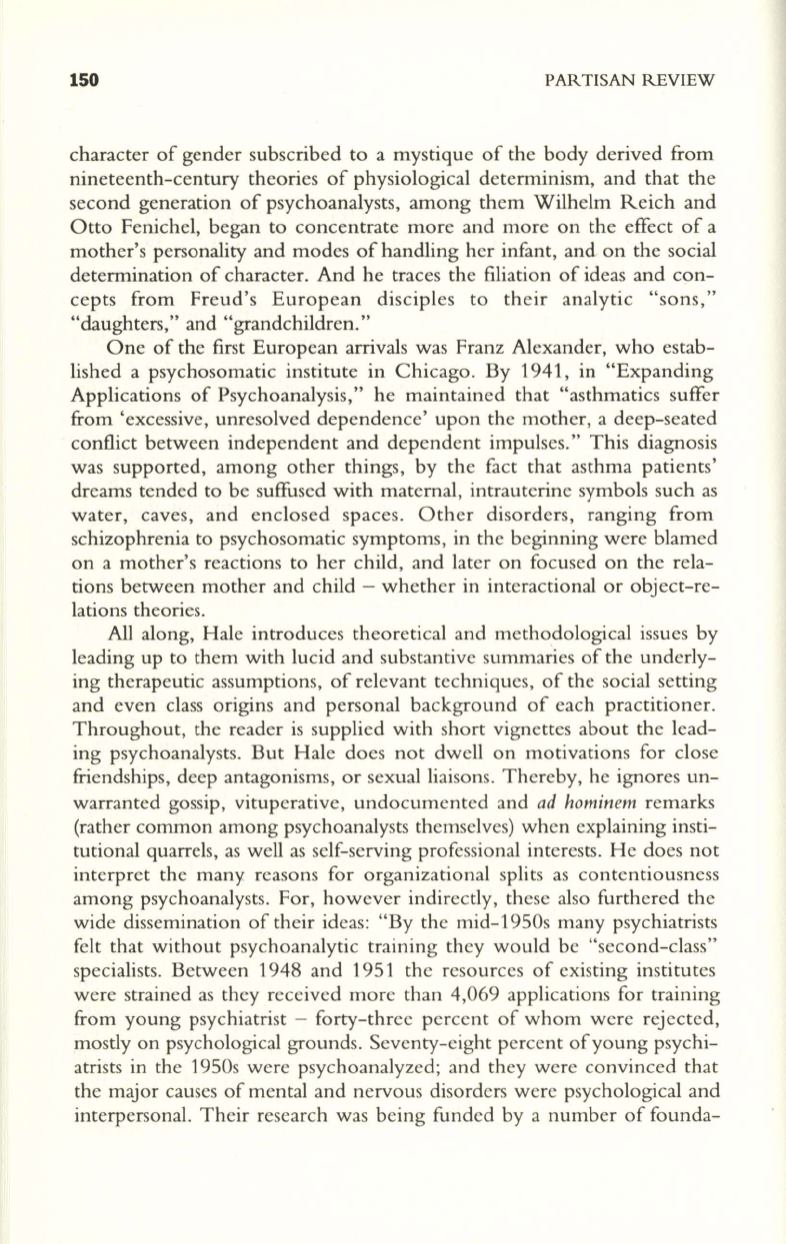
150
PARTISAN REVIEW
character of gender subscribed to a mystique of the body derived from
nineteenth-century theories of physiological determinism, and that the
second generation of psychoanalysts, among them Wilhelm Reich and
Otto Fenichel, began to concentrate more and more on the effect of a
mother's personality and modes of handling her infant, and on the social
determination of character. And he traces the filiation of ideas and con–
cepts from Freud's European disciples to their analytic "sons,"
"daughters," and "grandchildren."
One of the first European arrivals was Franz Alexander, who estab–
lished a psychosomatic institute in Chicago. By 1941, in "Expanding
Applications of Psychoanalysis," he maintained that "asthmatics suffer
from 'excessive, unresolved dependence' upon the mother, a deep-seated
conflict between independent and dependent impulses." This diagnosis
was supported, among other things, by the fact that asthma patients'
dreams tended to be suffused with maternal, intrauterine symbols such as
water, caves, and enclosed spaces. Other disorders, ranging from
schizophrenia to psychosomatic symptoms, in the beginning were blamed
on a mother's reactions to her child, and later on focused on the rela–
tions between mother and child - whether in interactional or object-re–
lations theories.
All along, Hale introduces theoretical and methodological issues by
leading up to them with lucid and substantive summaries of the underly–
ing therapeutic assumptions, of relevant techniques, of the social setting
and even class origins and personal background of each practitioner.
Throughout, the reader is supplied with short vignettes about the lead–
ing psychoanalysts. But Hale does not dwell on motivations for close
friendships, deep antagonisms, or sexual liaisons. Thereby, he ignores un–
warranted gossip, vituperative, undocumented and
ad hominem
remarks
(rather common among psychoanalysts themselves) when explaining insti–
tutional quarrels, as well as self-serving professional interests. He does not
interpret the many reasons for organizational splits as contentiousness
among psychoanalysts. For, however indirectly, these also furthered the
wide dissemination of their ideas: "By the mid-1950s many psychiatrists
felt that without psychoanalytic training they would be "second-class"
specialists. Between 1948 and 1951 the resources of existing institutes
were strained as they received more than 4,069 applications for training
from young psychiatrist - forty-three percent of whom were rejected,
mostly on psychological grounds. Seventy-eight percent of young psychi–
atrists in the 1950s were psychoanalyzed; and they were convinced that
the major causes of mental and nervous disorders were psychological and
interpersonal. Their research was being funded by a number of founda-


